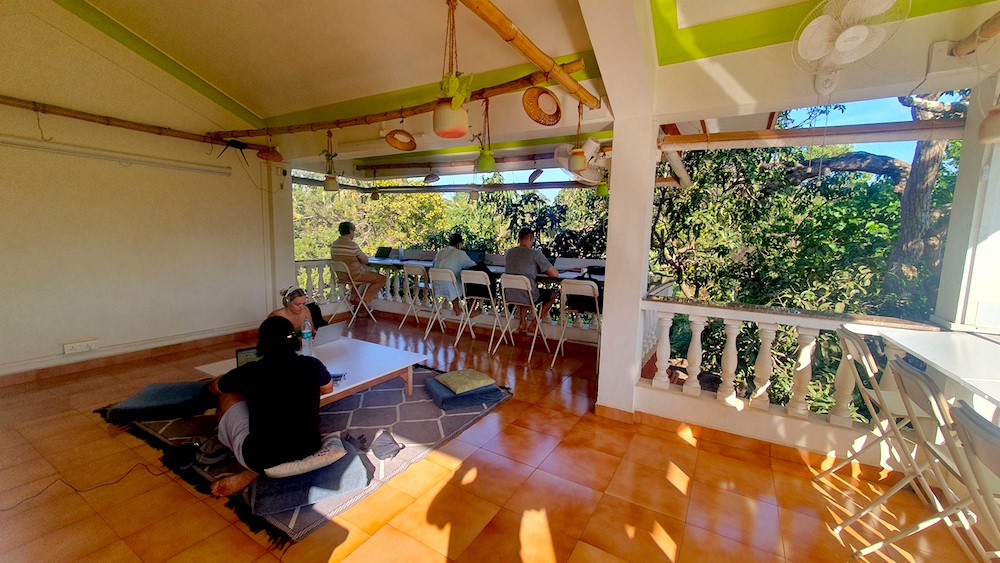While Portugal, Mexico, Cape Town, Bali and Thailand get most of the attention when it comes to digital nomad destinations, India is up and coming and one to watch in 2025 and beyond!
I was on a trip to India between January and April 2024 to see and experience India for myself as a European digital nomad.
My India trip included the sprawling metropolis that is Mumbai and the home of Bollywood.
The northwestern state of Gujarat, the home state of Prime Minister Narendra Modi and where my grandparents come from.
A couple of wonderful weeks in the bohemian classic Goa for some winter beach time. The water there in January was absolutely perfect!
Also, time in tech city Pune and the palace-filled northern state of Rajasthan including the cities of Jaipur and Udaipur.
Agra, of course, to visit the Taj Mahal as well as Chennai in the South and the former French colony Pondicherry.
I was lucky to do the trip with my mum who has been travelling to India for years and knows how to get things done and get around with relative ease. A lot of the tips in this guide are because of her, thanks mum! : )
I documented much of my trip on Instagram @globalcircler
To get tips from my digital nomad experience in India, read on!
An introduction to Goa, probably the most popular destination in India for westerners and digital nomads
Goa is a truly special and beautiful place surrounded by lush forests and offering stunning beaches with the warmest water. Ideal as a remote work getaway when it’s winter in Europe.
Goa has a rich and interesting history that included Portuguese rule for over 450 years. It began in the 16th century and came to an end in 1961 when India sent in their army and took back Goa.
I saw many Westerners in Goa, varying from hippies and backpackers to digital nomads. I stayed just over 11 days in Goa, mostly in the Anjuna beach area where I had the opportunity to try out a nice co-living/co-working community called NomadGao.
Goa is very chilled compared to the bigger Indian cities like Mumbai, think Lisbon vs the Algarve and you can get a bit of an idea.
Goa is also very well known for the party scene. This time around I didn’t get a chance to check it out but saw a lot of billboards for party nights featuring international DJs.
This I need to check out the next time I’m in Goa. It’s definitely a place I will be returning to as a global circler!
NomadGao Vila Nova, Anjuna, Goa image gallery
How is internet access? Mobile data plans and coverage and how to get a sim card in India
How is wifi access and coverage in India?
Now I’m about six weeks into my exploration of India as a digital nomad and can share my experiences when it comes to getting a mobile pay as you go sim card, wifi access and quality in general and mobile data coverage while working remotely.
I have travelled across several states and have been in major metropolitan cities like Mumbai, Pune and Rajkot as well as holiday destinations like Goa and rural agricultural towns like Savar Kundla in Gujarat.
In hotels and homes wifi access is pretty reasonable and reliable. Most hotels and hostels offer wifi in rooms, some only in common areas.
In India, there are occasions when there is a power outage, however, if you have a fully charged laptop and a charged mobile with a mobile data plan you can continue working for a while without any problem as I have done a few times. I was able to continue working until power was restored.
In India, there is a system of power distribution where on a certain day of the week electricity is not available for some hours. It’s known in advance so it’s possible to prepare.
If you have a fully charged laptop and a mobile hotspot setup or are in a place like a co-living or co~working with a power generator you will be fine.
It’s not very often though thankfully. As India is very much a tech nation, internet access is pretty crucial.
How to get a mobile sim card in India as a foreigner
It’s not the easiest thing to get a sim card in India as a foreigner but also not impossible! I was very lucky as I have a cousin living in Mumbai who got a sim card in her name for me and I just had to pay her for it.
However, during my travels in India, I met other foreigners who said they were able to get a sim card at the airport and gave the contact phone number and address of the hotel they were staying in and that did the trick. You will need an address and phone number.
I got a sim card from Indian mobile operator JIO, it costs around 300 rupees per month (about £3) and provides unlimited local calls, 2gb data per day and 100 SMS messages. I found in most places the mobile data was fast enough for day to day work when I created a mobile hotspot. Typically giving me 7mbs average.
Once you have your mobile sim card there are mobile shops everywhere, from the biggest cities to the smallest villages and towns as everyone has smart phones!
When I recharged my phone there was a guy sitting outside a mobile phone shop whose only job was topping up mobile phones.
You simply give him your number, he’ll tell you a price and he does it there and then.
Often the mobile phone shops selling phones and accessories don’t do it themselves as it’s probably not worth the money.
Just ask and they’ll point you in the direction of someone who can help. That’s what I did.
One option to get faster speeds from your mobile data would be to get a mini hub where you can insert your sim card as usually the speed gets throttled if you are creating a mobile hotspot from your phone.
They are usually not very expensive and could be a good option if you need faster speeds.
How is accommodation in India for foreign travellers? Below is my personal overview of hotels and guest houses in India for backpackers/budget travellers
Manage your expectations! The standards for hygiene, amenities and even hospitality vary a lot in India!
I have travelled across several states in India and chose to some degree to stay in budget accommodation as I was moving around a lot and travelling for three months total. I have stayed in Mumbai, Goa, Pune, Lonavala, Udaipur, Jaipur, Agra and Pondicherry so far.
Beware of online reviews!
I got the distinct impression that reviews in India get gamed a lot. Not to say it doesn’t happen elsewhere but here I really noticed it. If you are looking for a place to stay and there are less than 10 reviews they will inevitably show 5 star reviews. What I did was look for hotels and guest houses that had 100 or more reviews and scanned the reviews to get an idea. In most cases this worked.
Hygiene standards in India are different to what I am used to in the west!
I have stayed in all sorts of accommodation in many parts of the world, from budget through to high-end and everything in between. The standard of hygiene and amenities are sadly lacking in India based on my experience. It can range from horrendous to ok and sometimes nice.
Naturally, once you pay more and enter the realm of luxury hotels from international chains like Marriott and Radisson things will improve but that’s to be expected with the higher rates.
In Europe, you can stay in budget chains like Ibis and Travel Lodge and more often than not you’ll get a good, clean budget room that will satisfy your needs.
In India, wet rooms are common. You’ll get a bucket to fill and you can bathe that way or you’ll usually get a shower as well. The high-end hotels will provide a proper shower cubicle.
Don’t expect toilet paper!
Toilet paper isn’t a given! Some hotels that regularly accommodate foreigners in places like Goa will usually have toilet paper in the bathroom. If you don’t see any ask in reception. Best though is to carry a roll of your own!
In terms of price, you can expect to pay on average between 1000 Rs to 3000 Rs depending on where you are for a budget hotel room. That’s roughly £10 – £30 per night. If you are earning in GBP, dollars or Euros it’s not too expensive and if you are only in a city for work/sightseeing a budget hotel will do the trick in most cases unless you really want to get luxury treatment and amenities.
In my experience service and hospitality levels are far from what we’re used to in the West. This is not an absolute and I’ve been lucky to stay in places where the hosts were really kind but in most cases there just isn’t the attention to detail or emphasis on making the guest happy. In some cases the opposite, actually being rude and unhelpful. Hopefully, this will improve as India modernises.
Free Wifi is usually available in most hotels, hostels and guest houses in India
The all-important Wifi is reasonably reliable and fast enough for work needs. Sometimes you may not get Wifi in your room but in common areas but mostly it’s in room as well. Speeds vary from 10 – 20mbs to 100mbs+ sometimes. For most needs I found the wifi to be stable and fast enough to work and in the evenings watch some Netflix.

How to get around once you are in India as a digital nomad or backpacker exploring India for the first time
During the last two and a half months I have used every form of transportation in India except for a bicycle. Below is a guide to each of the different types of public transport used to get around India
During my travels, I used pretty much every form of public transport available, this included several sleeper buses, public trains, metros, private hire taxis, rickshaws, an internal flight and also on the back of a friends motorcycle or scooter. The sleeper bus was a completely new experience, but I’d say a pretty inexpensive way of covering large distances in reasonable comfort.
Below are my tips and experiences

Sleeper buses in India
Sleeper buses or coaches as we might call them in Europe are an incredibly popular way of moving from city to city across India at an affordable price.
As you might expect from the name, you would typically board a sleeper bus in the evening, travel through the night and arrive in your destination the next morning.
Sleeper buses in India are specially converted coaches that have sleeping cabins, single and double and on two levels.

When booking, it’s recommended to book the lower bunks as they are easier to get in and out of and especially if you are older or maybe don’t have great mobility.
Sleeper buses in India are quite comfortable, are usually air-conditioned and come with an AC power outlet so you can charge your phone or even use your laptop on the move.
Sleeper buses in India rarely have toilet facilities, but do stop every few hours for a toilet break and for you to have a meal or a snack.
In terms of price, Mumbai to Goa costed around 1600 rupees, which would be about £16 or €18.
I boarded in the evening around 9.30pm and was in Goa by around 7.30am.
There are apps to book from, but I found it tricky without having a local bank or card.
What is recommended is going to a local travel agency and booking the bus there. You pay on the spot, and they will confirm and give you instructions on where to board and where you will get off. Little travel agencies are everywhere in India, you’ll always be able to find one in a town, city or even village. Just ask around. People are usually helpful and will point you in the right direction.
Beware that often the pick up point is on the side of a highway where the bus will only stop briefly. Othertimes it will be from a proper bus depot. It can be a bit confusing so be aware!
Trains, regular and sleeper trains in India
I used the train several times. A few times in Mumbai to go to the Churchgate area from Andheri West.
This is a regular commuter train that costed about 20 rupees (£0.20) one way for a 40 min journey.
There were no allocated seats. I would suggest avoiding busy times as it gets packed and there is no “after you please…” kind of thing, it’s every man, woman and child for themselves and something you need to get used to!
Another thing to note and uncommon in Europe, is women-only carriages. If you are a woman, look out for one; if you are a man, be sure to get into a regular carriage or you could be fined and will get strange looks.
There are different classes as well. You can book a first class ticket, which will be less crowded but isn’t more luxurious.
I also took the very modern Vande Bharat Express train from Udaipur to Jaipur. This is the latest train in India and is extremely clean and comfortable.
Modern and clean toilets and decent catering are included. If you can get one for a route you want do make a point of booking the Vande Bhatat. The Vande Bharat Express entered service in 2019 and usually covers distances of up to 800km / 10 hours.
The longest train journey I took was a whopping 33 hours, 2016km from Agra (after visiting the Taj Mahal) to Chennai in the south of India (no Vande Bharat Express available sadly on this route)
As I booked the train relatively last minute, the only option was what is called a 3A (3rd tier AC sleeper).
this carriage, there were 8 very cramped bunks and in the next carriage, the grossest toilet I have ever seen.
It was one of the hole in the ground variety which I was determined not to use if I could help it lol.
The train was on time and got me to my destination, but I wouldn’t say it was a pleasant experience.
It was noisy and cramped and quite old and dirty. They did provide clean and freshly ironed sheets and a blanket though which was nice.
That particular journey costed around 2200 rupees (about £22), which is not bad considering the distance, but I would recommend booking early and getting a first class or 2A which is a bit better I’ve heard.
If you are short on time and don’t mind spending a little extra, you might be better off taking an internal flight.
It was an experience, but not one I would want to repeat, more one of the been there, done that, no need to do it again!
Booking trains in India can be very tricky. They are super popular and book up really fast. I booked several trains (Udaipur to Jaipur, Jaipur to Agra and Agra to Chennai) from a travel agent in Udaipur.
He booked them for me and charged me 200 rupees per ticket as a service fee.
There is an app called Ixigo Trains in India that allows you to book online. It’s handy to see what trains are available. I didn’t use the app to book, but I think it’s possible as a foreigner.
A private hire taxi with driver in India
Another popular, if relatively expensive, means of travel is a private hire taxi.
You can usually book one of these private taxis via a travel agent or your hotel will know of someone (they usually get a commission and will set it up for you).
In terms of cost, a three-hour journey in an air-conditioned car will set you back around 3,000 rupees if you haggle. That’s about £30. If there are several of you and you want ease and comfort, this is a really good way to go.
It is also quite common to hire a private taxi with a driver for several days.
Let’s say you want to do a tour of Rajasthan. The driver will take you to the main tourist spots or you can request where you want to go.
They will stop when you need to, e.g. to eat something and will either take you to a hotel according to your budget or to your already booked accommodation.
The cost of the taxi will vary, you need to negotiate and get an all-in price that includes tolls and driver food and accommodation which isn’t very expensive.
If several of you are travelling at once and you want to avoid the stresses of public transport or have limited time, this is a really good option.
Do keep in mind that the driving style is very different in India and takes some getting used to. I used a private taxi several times during my trip and it was really good, no complaints.
This leads me nicely onto the back of a motorbike experience. Scooters and motorcycles are the most used transport. People rarely wear helmets, although some do. I was on the back of a motorcycle a few times with a friend who I trust, he or I didn’t wear a helmet, it was a bit hair-raising at times but was ok, not too scary.
Getting and using a rickshaw in India
Rickshaws or tuk-tuks are everywhere in India and are used extensively by Indians and tourists alike.
A short journey of a few km will cost you somewhere around 100 – 150 rupees. Be sure to haggle though.
If they see you are a foreigner, they will try to charge you more.
One tip for you, if Uber is operating in the city you are in, say Mumbai for example, you can book Rickshaws on the Uber app, they are cheaper and avoid the need to haggle.
If nothing else, you can use the app to get a price and then show that to the Rickshaw driver to help you get a better deal or at least have an idea of how much the trip should cost.
He can’t really argue that much in this case and will either accept you or wave you away.
In the bigger cities, I’d recommend wearing sunglasses or glasses and a mask when travelling as it will help against the intense pollution, dust and particles flying around. An N95 mask is usually available from pharmacies at little cost. As rickshaws are open the masks do come in useful inside the cities.
Using Uber in India
I used Uber in Mumbai, Jaipur and Ahmedabad, three major cities and the coverage and availability were good.
I found the price of an Uber in Mumbai was the same or maybe a little more than what I would pay in Lisbon, India is getting expensive!
Quick tip – when you arrive in India, let’s say Mumbai airport like me, you may not have internet access yet unless you have grabbed a local sim card or are roaming.
If you don’t yet have a sim card sorted out yet you should look for an Uber desk in the airport car park where the taxis are coming and going.
They will give you temporary wifi access which will be enough to use the Uber app and book your journey to your hotel. I did this and found it really handy at Mumbai airport.
Internal flights in India
There are internal flights in India operated by airlines like Indigo and Spicejet.
They are like Ryanair and Easyjet in Europe. Air travel in India is still too expensive for most people but is on the rise. It is estimated that air travel will boom in India making it one of the biggest aviation markets globally in some years.
I took an internal flight from Chennai in South India to Ahmedabad in Gujarat in North West India.
The flight cost around 6500 rupees (about £65) and was really good. Great service and a modern Airbus aircraft.
My whole flight experience was really pleasant I must say. From checking in bags to security to boarding, everything was fast and smooth. Maybe I got lucky but it was pretty faultless
How to cross the road in India
This is no joke, crossing a busy main road in India is a feat in itself, it requires a sense of bravado, self-confidence, a keen eye and nerves of steel LOL.
During my entire trip, I perhaps came across two pedestrian crossings with the red and green person. The rest, you are on your own!
What I was taught and what I did, rightly or wrongly was to look in the direction of oncoming traffic, find a slight gap and start crossing the road slowly. Nobody will stop to let you pass. You either wait forever or make a move. So, I looked towards the traffic, and stepped onto the road slowly, ideally I crossed with others looking to do the same thing and made my way over. What I found in India is that cars, motorbikes, buses, rickshaws etc are watching and will do their best to avoid you. So as long as they can see you and you aren’t running wildly across the road you should be ok. Of course, as a disclaimer, we cannot advise you what to do for obvious reasons but these were my personal experiences and what I did. You need to figure it out for yourselves when you are in India and hopefully, my experiences will help : )
Eating and drinking in India
This is of course a very important aspect of travel in general. The last thing we want to is to get sick abroad and have a ruined experience.
Over the years hygiene has improved in India however, it’s still advisable to take care when it comes to eating out in India.
The expression “Delhi belly” is a well-known one and many a person has fallen prey to this particularly unpleasant experience.
Drinking hot drinks like chai tends to be pretty safe no matter where you have them in my experience but water is one to be super careful about. These days in India filtered water has become much more commonplace and most people tend to have water filters at home. Restaurants will usually serve filtered water but it’s best to ask anyway.
When out and about purchase bottled water and of course ensure that it’s a legit-looking and sealed bottle. I did hear that there have been cases where unscrupulous people have been known to refill plastic bottles with plain water and sell it as mineral water. I never saw it myself but best to be safe.
You’ll find bottled water everywhere so it’s never difficult to get hold of.
In terms of eating out in India and especially street foods, it is advisable to be careful as you could very easily get an upset stomach or worse.
When it comes to street food use your common sense and see how clean it the food stall looks. If it looks clean and it’s busy it’s probably ok but I personally limited eating street food just to be safe.
In terms of restaurants, Google maps is your friend. I used it a lot to find places to eat. Now, I got the feeling that in India as mentioned above, ratings do get gamed so if there are only a few 5 star reviews there’s a fair chance they could be fake. I went for places with a 4 plus Google rating and where there were at least 80 or more reviews. The more the better.
If you are a vegetarian like me or vegan India is great in that practically all restaurants have “pure veg” and “non veg” signs. Places that are pure veg do not cook or serve any meat or fish, everything is pure vegetarian. If you are vegan you would need to choose dishes that are vegan or ask them to remove dairy which normally should be fine.
If you are a meat eater then non-veg places will cater to you as well as offer vegetarian dishes.
Now of course, this is India and you will get an abundance of delicious Indian food of every variety imaginable. One of the things to try is the thali. This is a set meal offering a selection of curries, pickles, daal, rice and dessert on a single large steel plate. In most cases, there will be people constantly serving you until you are full. It’s usually great value for money and will allow you to try a wide selection of dishes.
If you at some point need a change from Indian food as I did you will find international chains such as Pizza Hut, Dominos, McDonalds and Burger King to name a few. The menus are tailored to the local market but are very familiar in taste.
I found the cheese in India is not what I am used to in Europe, sometimes the cheese in India seems like a cheese sauce but in some places, you can get Cheddar and mozzarella but they weren’t the same as what I would in Europe. It’s just a case of adjusting to the local taste.
In terms of drinking in India. I personally didn’t drink alcohol on this trip but alcohol is available, especially in large cities and tourist destinations such as Goa. Please note that the state of Gujarat is dry. Alcohol is forbidden (think the prohibition era in the USA and Al Capone) but apparently, some hotels do have a license to serve foreigners.
Overall, I was pretty ok during my time in India with food although my stomach was almost always feeling slightly off. I did take Imodium with me but never needed it. I’d recommend having it on hand just in case.
While I was fortunately very lucky in that I didn’t fall sick or have an accident, it would be highly recommended to take out digital nomad insurance and or travel insurance of some sort. For absolute peace of mind I’d recommend the Complete Insurance offered by SafetyWing.
The doctors in India are pretty good from what I understand and there are plenty of small private clinics and health centres that you will be able to find in every town, city or village. Unless you are in a very rural village you should be fine speaking English.
Final thoughts on my digital nomad experience in India
After spending three months travelling quite extensively in India while remote working I can say that it was overall one of the best travel experiences of my life.
I have Indian roots as my grandparents are from Gujarat and I speak the language fluently so my experience might be a little different if you are not Indian and don’t speak the language.
However, I am very much a European in my mind when it comes to everything else and if anything, I have come to appreciate all the things I may take for granted in Europe such as cleanliness, peace and quiet (depending on where you are of course!), variety and politeness.
I found the people in India generally really nice and in most cases helpful. There are times though that they can come across as rude or unhelpful but this is a cultural thing I am sure.
What surprised me quite pleasantly was that I didn’t see that much extreme poverty, rough sleepers or beggars. I get the feeling I saw more in Lisbon or London in relative terms.
It feels like India is on the up and up and is catching up with the West in many ways. I should stress, however, that India has a very deep history and culture and perhaps in some ways the rest of the world is catching up with India but that’s another subject altogether!
One of the things that fascinated me was the high level of activity in India. It’s constantly buzzing, from small villages to large cities like Mumbai, it’s a hive of activity.
I got the distinct impression that there is very little reason to starve in India as it’s a country full of opportunity if you are prepared to work hard and hustle which is very much built into the cultural fabric of India.
Overall, I would say go and spend time in India as a digital nomad. It’s better to go sooner rather than later as maybe in ten years much of what I experienced for better or for worse may no longer exist as India modernises.
I found India pretty safe throughout my travels and of course, we should always be careful and alert on our travels as anything can happen.
I hope this helps anyone who’s thinking of exploring India as a digital nomad. If you have any comments please post them below or get in touch if you would like us to add anything.









Thanks for sharing your experiences! I’m heading to India for the first time in October for up to 5 months, and I’m really not sure what to expect – other than adventure and amazing spicy food. The majority of my nomad friends have a negative outlook on nomading in India, and I should go for a vacation instead – so I appreciate your point of view. Cheers!
Hi Greg, thanks for your message. I’m happy to share my experiences as a nomad. I’d say it depends a lot on what you are looking for in your nomad trips and how adventurous you are. India is certainly an experience you will never forget. Goa is a pretty safe spot in terms of being accustomed to catering to foreigners, it’s a really nice place to visit and lovely beaches. There are cafes and places to co-work. I mentioned one in the article that I tested out. Mumbai is international and will give you a taste of everything, beaches, an authentic India experience and also higher end experiences as well. In terms of food, it is a curse and a blessing in my experience. I was ok but was careful what I ate. On the whole it’s fine but there’s always the risk of delhi belly! It’s not just down to hygiene (which can be questionable compared to the west at times) but also just the level of spice, the amount of oil, etc. It can get very rich. Overall I would recommend it. I really enjoyed it myself and it’s a trip like no other. It’s an experience! In terms of wifi/working I rarely had problems getting online. You’ll always find wifi and also with mobile data and a hotspot you are pretty safe for most normal work. I hope that helps, any more questions please feel free to ask : )